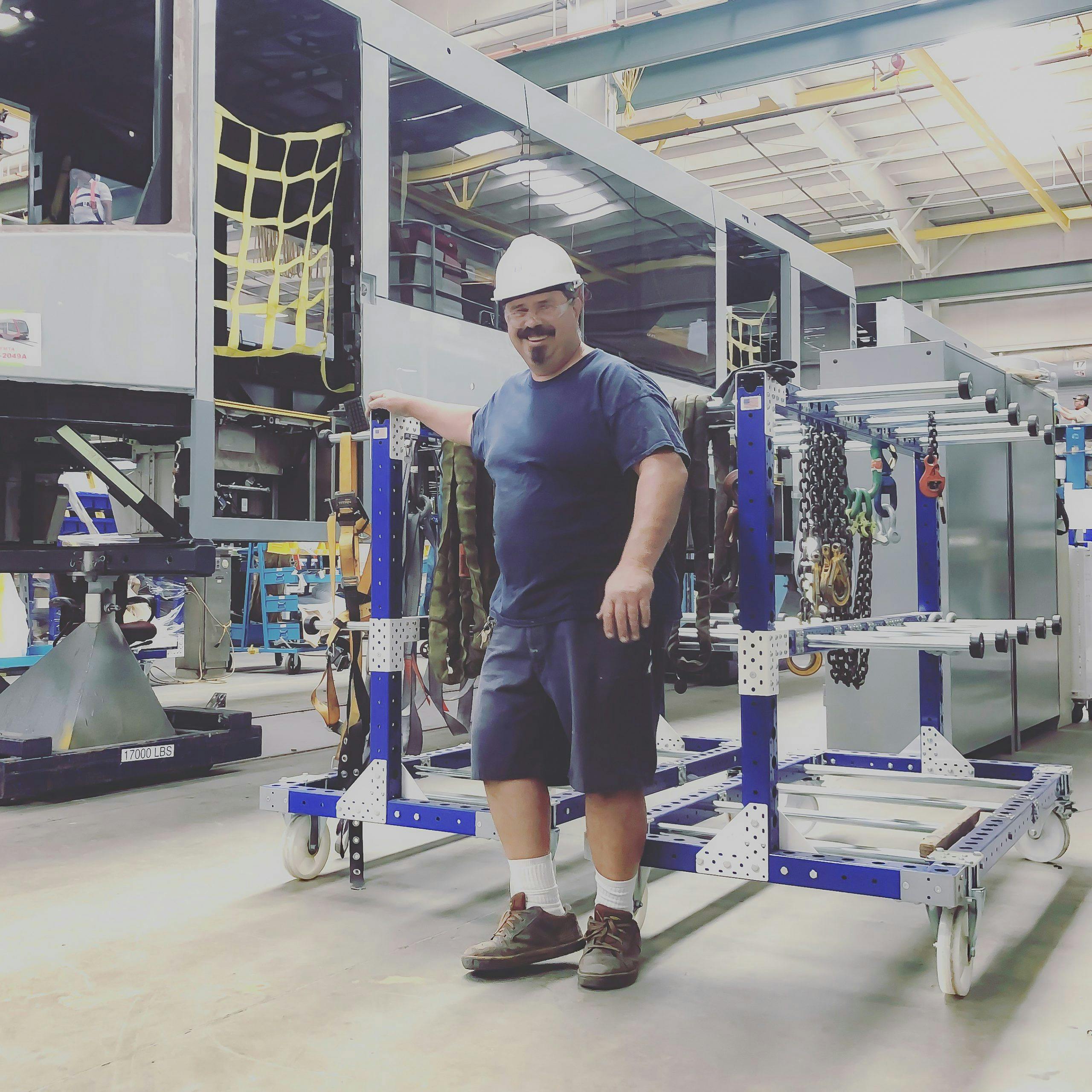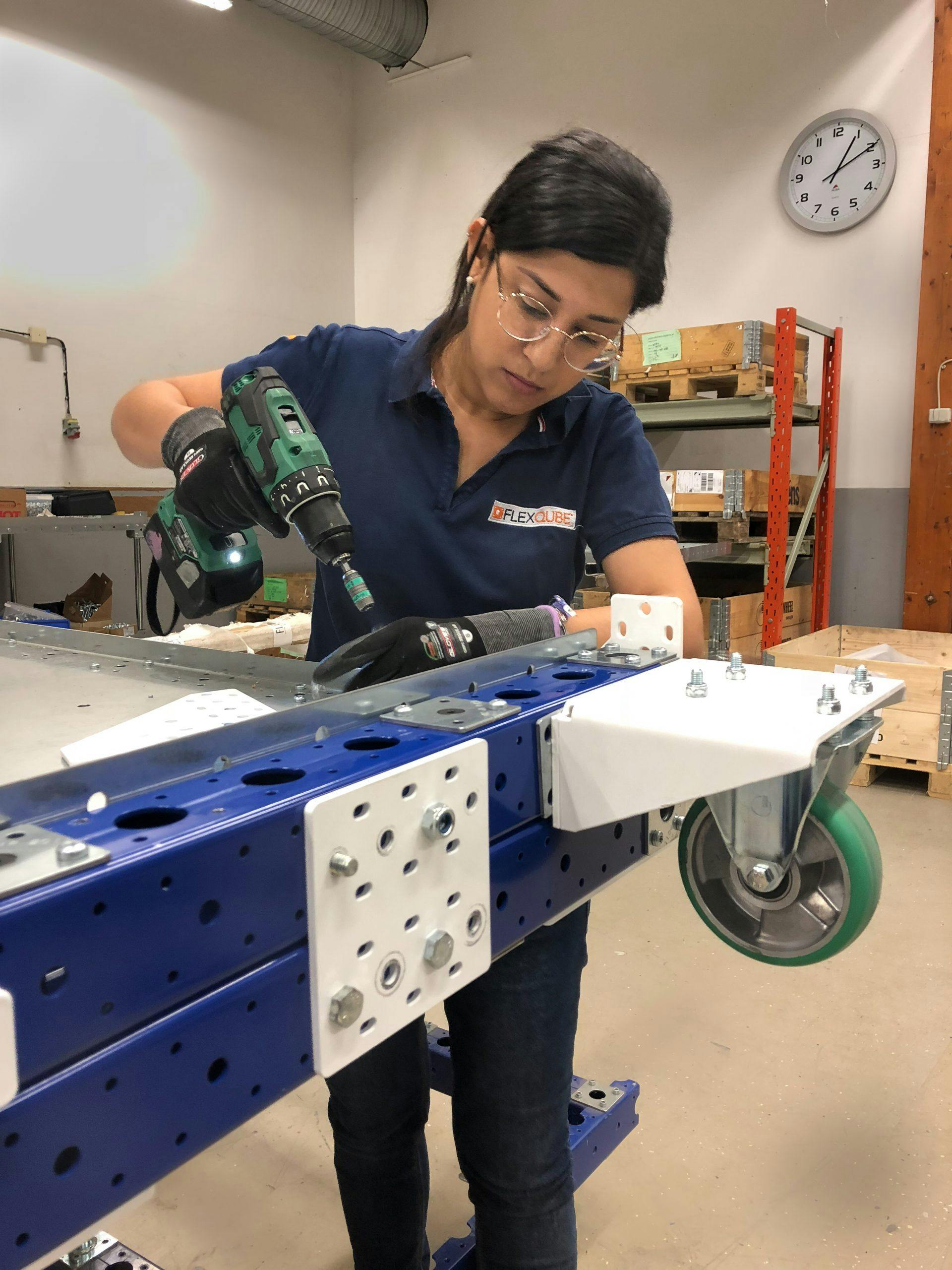Manual Material Handling Tips for a More Ergonomic Work Environment

Manual material handling is a labor-intensive process that comes with safety connotations.
Inadequately designed material handling systems can lead to accidents on the shop floor, body pains, and other health risks. Thus, understanding the ergonomics behind material handling is required to design efficient work environments within warehouses and manufacturing facilities.
According to the International Ergonomics Association Executive Council,
“Ergonomics is the scientific discipline concerned with the understanding of the interactions among human and other elements of a system, and the profession that applies theory, principles, data, and methods to design in order to optimize human well-being and overall system performance.”
Within the shop floor, interactions within material handling systems and shop floor operators must also be understood to optimize manual material handling procedures.

Elements that Makeup Manual Material Handling Systems
The elements that make up a manual material handling system include carts, pallets, or trays for loading and transporting materials on the shop floor. The carts utilized on the average shop floor are equipped with loading and unloading gear, swivel casters that provide specified degrees of rotational freedom, load platform, and handles. Handles are used to support the transportation process, and swivel casters can be equipped with braking systems to ensure carts can be controlled.
Pallets are manual material handling solutions with the capacity to transport load. The average pallet is a flat platform that can be loaded on a trolley to transport items across the shop floor. Like carts, pallets come in different configurations and designs, which should be optimized to ease the material handling process.
The system layout is another important aspect of the material handling system as it determines how materials are moved across a facility. Optimized layout designs simplify the order pickers or operator’s material handling activities, and it also reduces the human errors that can occur when executing material handling processes that are repetitive.
The shop floor also consists of the ground where manual material handling solutions are transported across. The ergonomic situation of a facilities floor determines how easy or difficult the material handling process will be. Thus, when considering optimizing working conditions or environment through ergonomic study, the aforementioned elements must be considered.
Tips for Designing a More Ergonomic Environment for Manual Material Handling
An optimized manual material handling environment is one that ensures every element involved in the material handling process is designed to ensure ease of use. Thus, ergonomic design tips must consider the manual material handling equipment used, the shop floor layout, and the state of the physical shop floor.
01. Develop Optimized Layout Designs
Layouts with dedicated material handling pathways and easily navigable in-roads reduce shop floor traffic when handling materials. Optimized designs also ensure facility owners can easily adopt diverse material handling techniques that deliver just-in-time services.
The first tip to designing an ergonomic environment for manual material handling is to use digital design tools. Quite ironic, isn’t it? Digital transformation technologies such as 3D CAD modeling software ensure optimized layouts can be modeled, while augmented reality headsets can be utilized to evaluate designed layouts before physical implementations are executed.
Digital technologies support iterative layout design, thus ensuring the diverse margins for error are discovered and worked on to develop an optimized layout.
02. Ensure Clear Pathways
Not all facility owners have the resources or space to develop dedicated material handling pathways that serve only the material transportation processes. In many facilities, material handling systems are built alongside existing shop floor walkways. This layout design pattern can lead to health and safety incidents as both operators, and material handling equipment are bound to clash.
Material handling systems be assigned to dedicated pathways for transporting materials. If this isn’t possible, then the tip here is to ensure that optimized material handling schedules are developed and enforced when transporting heavy-duty equipment or materials. The schedule should limit shop floor traffic to enable the passage of these materials to their assigned workstations.
03. Choose Manual Material Handling Equipment that Fit
Multiple materials handling equipment options exist. These options include pallets, carts, trolleys, tugger carts, etc., which can serve as a means for transporting materials across the factory floor. When selecting from these options, the tip is to consider the layout design and size of transportation pathways.
Taking into consideration these elements will ensure the options selected to fit perfectly within the warehouse of the factory floor without impeding regular operations. The choice of customizing a manual cart also exists, and it will be explored down the line.
04. Solve Worker Complaints
Feedback from the order pickers and operators who use and rely on manual material handling systems to execute tasks has first-hand experiences that can be leveraged to develop ergonomic designs. The initial layout plans should focus on solving existing issues to ensure shop floor operators are comfortable utilizing manual carts within the designed shop floor.
With these tips in mind, an optimized material handling system for manual equipment can be designed. Once implemented, the next step is ensuring the manual material system is utilized at its full capacity within the ergonomic environment.

5 Manual Material Handling Tips to Optimize Performance
Manual material handling equipment is susceptible to wear, which, in turn, affects the handler using worn-out equipment. Thus, operating manual material handling equipment must be done with care to ensure long-term operations and optimized productivity even on an ergonomic shop floor. These 5 tips should help with properly optimizing manual material handling equipment:
01. A Balanced Cart
Loading material handling equipment is a task that must be done correctly. Transporting manual material handling equipment such as carts with undistributed load means the handler will have to overcompensate when pushing the cart. For heavier loads, regardless of how the handler compensates, the imbalance can lead to damaging the transported material and awkward standing positions for the handler.
The loading tip here is to ensure the load is properly distributed across the surface of the cart. The even distribution of load is done by placing heavier objects on lower shelves and distributes weight from left to right. It is also recommended that loaded carts should not have items sticking out from the sides as they can snag on other assets on the shop floor leading to accidents.
02. Push not Pull
The handles on most carts are located at the rear end with the load at its front for a reason. The reason is to nudge handlers to push carts along paths, not pull them. Pulling carts leaves the handler at the mercy of the load being pulled and also puts other operators on the shop floor in danger. Pulling also reduces the amount of force the handler can exert to get the cart moving in the right direction.
The tip here is to ensure handlers and order pickers are trained to handle carts on the shop floor correctly.
03. Park Carts Properly
A professionally designed layout should account for parking positions for carts. Although these positions solve the cart storage issue, they sometimes don’t address the need to park carts when in transit or after getting to the drop-off point.
When parking manual material handling equipment, the tip is to ensure the equipment is placed near a wall to forestall errant movement. Material handling equipment shouldn’t be parked near exits, doors, or walkways as they can cause traffic. In emergencies, improperly parked cars can hinder movement, thus escalating the situation.
04. Implement a Predictive Maintenance Schedule
Proper maintenance increases the lifespan of material handling equipment. Taking a leaf from industry 4.0, facility owners can leverage historical repair data to develop predictive maintenance strategies that increase the lifespan of material handling equipment.
Maintenance strategies must focus on the wheel alignment of carts and ensure casters are properly lubricated. Maintenance should also be facility-wide to ensure pathways are smooth and conducive for transporting materials.
05. Schedule Operator Training
Installing a material handling system is the first step to building an ergonomic environment. Ensuring order pickers and operators who intend to use this equipment have the required safety training is just as important. Facility owners must ensure regular training is held with every update to the material handling system within the shop floor.
Customizing Material Handling Equipment
The choice of customized material handling equipment is a powerful option facility owners can explore when seeking to build an ergonomic work environment. Modular designs offer multiple configurations that fit complex shop floors or unique layouts. These modular designs support scalability when increased workloads are to be transported. It also enables the possibility of repairing the existing carts when needed instead of buying new ones. Continuous repairs or customization alongside the changes of your materials can be crucial to obtaining ergonomic manual material handling.
The customization process generally involves speaking to an experienced material handling service provider to create plans that fit your environment. The customized design should take into consideration the ease of use and safety features required to simplify the material handling process.

Conclusion
An ergonomic industrial environment accomplishes two important tasks. The first is increasing the lifespan of the material handling equipment used within the environment, and the second is to ensure the safety of operators on the shop floor. The tips highlighted here are provided to help facility owners achieve these two important factors to optimize productivity.


